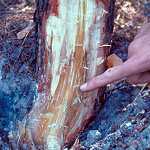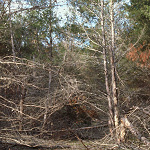 |
The Global Invasive Species Team |  |
|
Gallery of Pests:
Pests & pathogens that are widespread Phytophthora root rot - Phytophthora cinnamomi Ronds - Faith Campbell - - August 2004 - Photographs Click on the images below to view photographs. Complete photographic credits are given here.
Phytophthora root rot
The American chestnut (Castanea dentata) and the related Allegheny and Ozark chinkapins (which are both varieties of Castanea pumila) probably began declining approximately 200 years ago with the introduction of the soil-borne algal fungus, Phytophthora cinnamomi. Throughout the 1800s, the disease gradually killed chestnut and chinkapin populations on relatively wet sites (Crandall et al., 1945). Unfortunately, Robin et al. (1994, 1998) reported that oak species growing in Europe, including the North American red oak (Quercus rubra), were becoming infected with this pathogen. Considering the importance of oak species in eastern forests, the impact of P. cinnamomi may not yet have been fully realized. Sources Crandall, R. S., G. F. Gravatt, and M. M. Ryan. 1945. Root disease of Castanea species and some coniferous and broadleaf nursery stocks caused by Phytophthora cinnamomi. Phytopath. 35: 162-180. Robin, C., F. Dupuis, and M. L. Desprezloustau. 1994. Seasonal changes in northern red oak susceptibility to Phytophthora cinnamomi. Plant Dis. 78: 369-374. Robin, C., M. L. Desprez-Loustau, G. Capron, and C. Delaour. 1998. First record of Phytophthora cinnamomi on cork and holm oaks in France and evidence of pathogenicity. Ann. Sci. Forest. 55: 869-883.
|
||||||||||||
Updated January 2005 ©The Nature Conservancy, 2004 |
|||||||||||||



